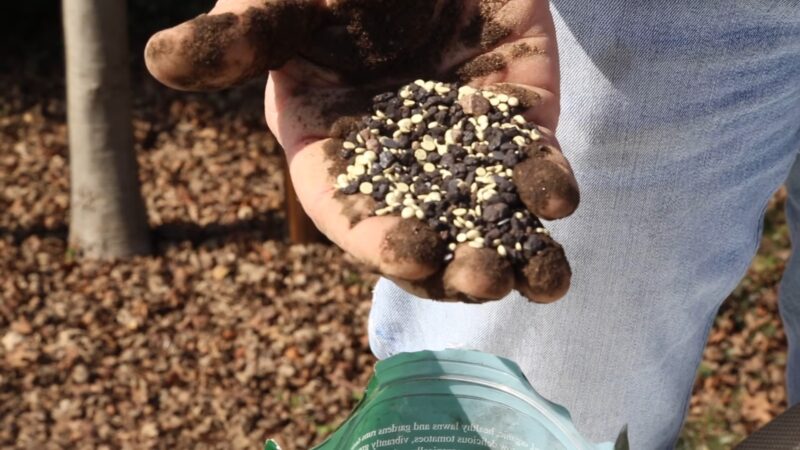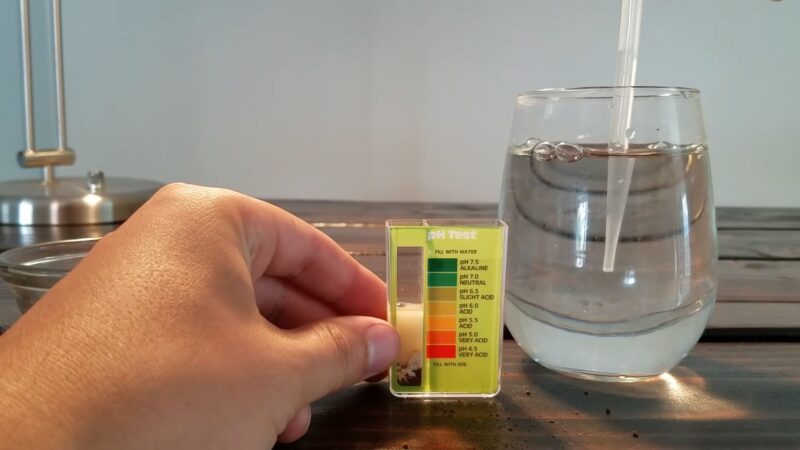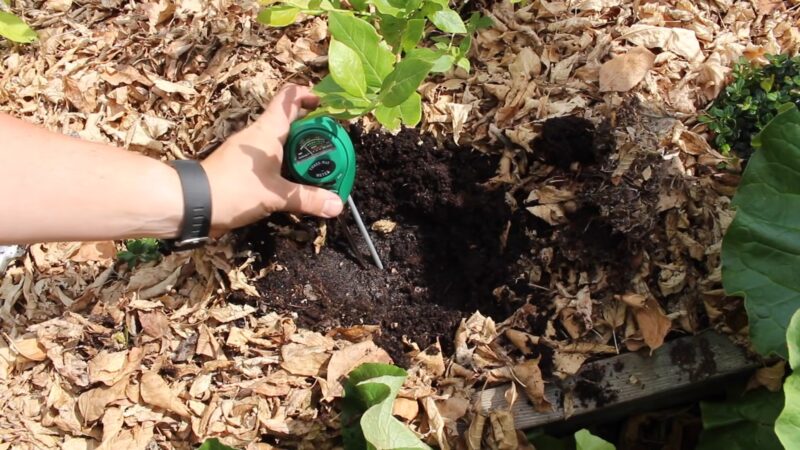Soil pH, which stands for potential hydrogen, is a crucial factor in gardening and agriculture. It determines how acidic or alkaline your earth is, directly impacting plant health and growth. Most plants prefer a pH range of 6.0 to 7.0, which is slightly acidic to neutral.
However, certain plants have specific preferences; for example, blueberries and azaleas thrive in more acidic soils, while plants like clematis and lilac prefer alkaline conditions.
In such cases, adjusting your soil’s acidity level is not just beneficial but often necessary for the health and productivity of your garden. This adjustment process requires knowledge, precision, and patience, as soil chemistry is delicate and can significantly affect plant nutrient uptake.
Today, we’ll explore how you can ensure optimal growing conditions for a wide variety of plants.
Adjusting Soil pH
Making It More Acidic
| Method | Description | Effectiveness | Application Guidelines |
|---|---|---|---|
| Organic Materials | Natural options like sphagnum peat, pine needles, and sawdust release acid as they decompose. | Gradual acidity level reduction depends on factors | Apply consistently over time for noticeable changes. |
| Elemental Sulfur | Interacts with earth moisture and microbes to form sulfuric acid, effectively lowering acidity level. | Effective, varies with soil type and pH | Follow recommended application rates and frequency to prevent plant damage. |
| Aluminum Sulfate | A faster-acting alternative to elemental sulfur quickly acidifies the earth. | Quick acidity level adjustment, use with caution | Be careful not to overapply, as it can harm plant roots and earth organisms. |
| Iron Sulfate | Similar to aluminum sulfate, it rapidly lowers soil acidity levels. | Quick pH adjustment, handle with care | Avoid excessive application to prevent toxicity to plants and earth organisms. |
Making Soil More Alkaline

| Material | Description | Usage |
|---|---|---|
| Lime (Calcium Carbonate) | Increases soil pH by neutralizing earth acidity through a reaction with hydrogen ions. | Commonly used for acidity level adjustment, the amount varies based on soil pH and texture. |
| Dolomitic Lime (Magnesium Carbonate) | Similar to agricultural lime but also provides magnesium. | Used for pH adjustment, especially in magnesium-deficient soils. The amount depends on the earth’s conditions. |
| Wood Ash | Contains calcium and potassium, which can raise soil acidity levels. Alkalinity varies; use cautiously in small amounts. | It is effective for acidity level adjustment but should be applied carefully due to varying alkalinity. |
| Oyster Shell Lime | Slowly neutralizes acidic earth, similar to agricultural lime. | Less common but useful in calcium-deficient soils. Application rates depend on soil needs. |
| Crushed Marble | Works like agricultural lime to increase soil pH. | Effective in pH adjustment, especially in calcium or magnesium-deficient soils. Application rates vary with earth conditions. |
Application Tips
- Apply in Small Amounts: Gradual application of earth amendments is more effective and safer than large, infrequent applications. This method allows the soil to adjust slowly, preventing shock to plant roots and microbial communities.
- Incorporate into the earth: For maximum effectiveness, mix amendments into the soil rather than just spreading them on the surface. This ensures even distribution and better interaction with earth particles and roots.
- Re-test Soil pH: After applying amendments, it’s important to re-test the soil acidity level after a few months. This helps determine if further adjustments are necessary and prevents over-correction.
How to Maintain Soil Acidity Levels?

1. Ensure Regular Testing
Consistent monitoring through regular testing is key to maintaining desired pH levels. Annual testing is recommended, as it helps track the impact of any amendments made and indicates when further adjustments are necessary.
It’s also a good practice to test soil acidity levels in different areas of your garden or farm, as pH can vary significantly across different spots due to factors like drainage, organic matter content, and specific plant requirements.
2. Consistent Organic Matter Addition
Incorporating organic matter into your earth regularly can play a crucial role in stabilizing pH levels. Organic materials, such as compost, decompose to form humus, which has a buffering effect on soil pH. This means it can help neutralize both acidic and alkaline conditions, maintaining a more consistent acidity level over time.
Additionally, organic matter improves soil structure, water retention, and microbial activity, contributing to its overall health.
3. Mulching
Applying mulch is another strategy to help maintain soil pH. Organic mulches, like pine needles or hardwood chips, can gradually alter the acidity level as they decompose. Pine needle mulch, for example, can help maintain acidic conditions, while hardwood chips tend to be more neutral to alkaline.
Besides influencing pH, mulches also conserve earth moisture, regulate its temperature, and suppress weed growth, making them beneficial for multiple reasons.
Common Mistakes to Avoid
Over-Adjusting
A significant mistake in acidity level management is over-adjusting the soil, which can lead to extreme pH levels. Such drastic changes can harm plant roots, disrupt microbial communities, and lock out essential nutrients, causing stress and growth issues in plants.
It’s crucial to apply amendments gradually and monitor the acidity level regularly to avoid this problem.
Ignoring Soil Type
Different soil types react differently to pH amendments. For instance, clay soils, which are more dense and have higher cation exchange capacity, require more lime to increase acidity level compared to sandy soils, which are less dense.
Ignoring these can lead to ineffective acidity level adjustments and wasted resources.
Neglecting Plant Preferences
It’s vital to consider the pH preferences of the plants you are growing. Some plants, like rhododendrons and blueberries, prefer acidic soils, while others, like lavender and Russian sage, thrive in alkaline conditions.
Adjusting the acidity level without considering the specific needs of your plants can lead to poor growth or even plant death.
FAQs
Can I use vinegar to lower soil pH?
Yes, you can, but you should apply it with caution. Dilute it heavily with water (a general guideline is 1 cup of vinegar to 1 gallon of water) and apply it sparingly. Vinegar is a quick fix and not a long-term solution, as its effects are temporary and can vary greatly based on soil composition.
How does the presence of certain minerals in soil affect pH adjustment?
Minerals like limestone (calcium carbonate) and gypsum (calcium sulfate) naturally counteract earth acidity, making it harder to lower the acidity level in soils where these minerals are abundant. Conversely, soils rich in aluminum and iron tend to be more acidic and may require more effort to increase the acidity level.
Can changing the pH affect soil bacteria and earthworms?
Yes, it can significantly affect the microbial and earthworm populations. Most beneficial bacteria and earthworms thrive in a neutral to slightly acidic pH. Extremely acidic or alkaline soils can reduce their numbers, impacting soil health and nutrient cycling.
Is it possible to change the soil pH for container plants?
Absolutely. The soil acidity level in containers can be adjusted more easily than in open gardens due to the contained environment. For container plants, use specific potting mixes designed for the desired pH or adjust the pH of your existing potting soil using the same methods as for garden soil.
How does rainfall influence soil pH over time?
Rainfall, especially in areas with high precipitation, can lead to acidification. This happens as rainwater leaches away base cations like calcium and magnesium, which are responsible for neutralizing acids in the earth. Over time, this can lead to a gradual decrease in pH.
Can I change the soil pH for a specific area in my garden without affecting the surrounding areas?
Yes, you can target specific areas for acidity level adjustment. This is particularly useful in gardens where different plants with varying pH preferences are close together. Use barriers like plastic edging or apply amendments directly around the specific plant, being careful to contain the material in the targeted area.
The Bottom Line
Adjusting and maintaining the soil pH is a critical aspect of gardening. It ensures that plants have access to the necessary nutrients and thrive. By understanding the soil’s current acidity level, choosing the right amendments, and applying them correctly, you can create a conducive environment for your plants.
Always keep in mind that patience and regular monitoring are key to successful soil acidity level management.
